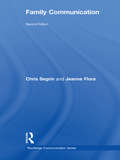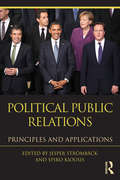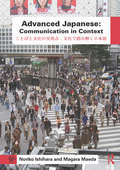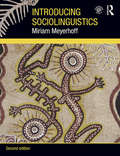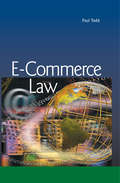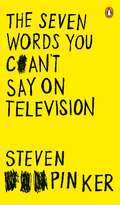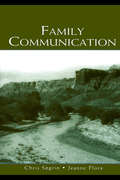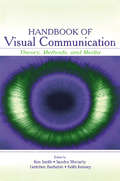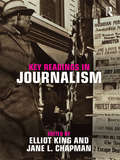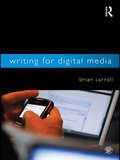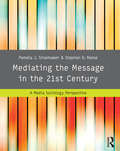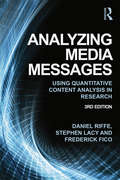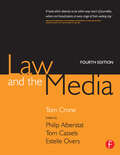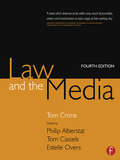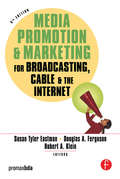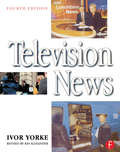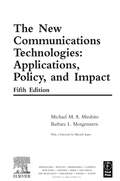- Table View
- List View
Family Communication: Chris Segrin (Lea’s Communication Series)
by Chris Segrin Jeanne FloraFamily Communication carefully examines state-of-the-art research and theories of family communication and family relationships. In addition to presenting cutting-edge research, it focuses on classic theories and research findings that have influenced and revolutionized the way scholars conceptualize family interaction. This text offers a thorough and up-to-date presentation of scientific research in family communication for both teachers and students of family communication as well as professionals who work with families. This second edition features: Chapters updated with the latest research, including over 2000 references. Material on understudied family relationships, such as extended family relationships and gay and lesbian relationships Recent research on understudied topics in family communication, including the influence of technology on mate selection, negotiating work and family stress, single parenting, cohabitation, elder abuse, forgiveness in marriage, and the links among communication, culture, and mental health. A revised chapter on parent-child communication, taking a lifespan perspective that helps organize the large body of research in this area. A new chapter devoted to extended family relationships, with special focus on grandparent-grandchild relationships, in-law relationships, and adult children and their parents. An expanded review of family conflict processes, especially in relation to decision making and power. A companion website provides chapter outlines, exam questions, and PowerPoint slides for students and instructors. Undergraduate readers should find the information easy to understand, while advanced readers, such as graduate students and professionals, will find it a useful reference to classic and contemporary research on family communication and relationships.
Family Communication (Lea’s Communication Series)
by Chris Segrin Jeanne FloraFamily Communication carefully examines state-of-the-art research and theories of family communication and family relationships. In addition to presenting cutting-edge research, it focuses on classic theories and research findings that have influenced and revolutionized the way scholars conceptualize family interaction. This text offers a thorough and up-to-date presentation of scientific research in family communication for both teachers and students of family communication as well as professionals who work with families. This second edition features: Chapters updated with the latest research, including over 2000 references. Material on understudied family relationships, such as extended family relationships and gay and lesbian relationships Recent research on understudied topics in family communication, including the influence of technology on mate selection, negotiating work and family stress, single parenting, cohabitation, elder abuse, forgiveness in marriage, and the links among communication, culture, and mental health. A revised chapter on parent-child communication, taking a lifespan perspective that helps organize the large body of research in this area. A new chapter devoted to extended family relationships, with special focus on grandparent-grandchild relationships, in-law relationships, and adult children and their parents. An expanded review of family conflict processes, especially in relation to decision making and power. A companion website provides chapter outlines, exam questions, and PowerPoint slides for students and instructors. Undergraduate readers should find the information easy to understand, while advanced readers, such as graduate students and professionals, will find it a useful reference to classic and contemporary research on family communication and relationships.
Political Public Relations: Principles and Applications (Lea’s Communication Series)
by Jesper Stromback Spiro KiousisPolitical Public Relations maps and defines this emerging field, bringing together scholars from various disciplines—political communication, public relations and political science—to explore the area in detail. The volume connects differing schools of thought, bringing together theoretical and empirical investigations, and defines a field that is becoming increasingly important and prominent. It offers an international orientation, as the field of political public relations must be studied in the context of various political and communication systems to be fully understood. As a singular contribution to scholarship in public relations and political communication, this work fills a significant gap in the existing literature, and is certain to influence future theory and research.
Advanced Japanese: Communication in Context
by Noriko Ishihara Magara MaedaThis innovative advanced level course in Japanese teaches appropriate language use in real life situations. With an emphasis on listening and speaking skills, the course takes a descriptive approach, demonstrating the variations that exist among Japanese speakers. Authentic sample dialogues demonstrate a range of generally preferred language uses, giving the student the tools to communicate in an effective and culturally appropriate manner. Organized according to frequently used functions of speech, such as requesting, apologizing, refusing and thanking and complimenting, Advanced Japanese presents commonly-used expressions and typical speech routines, providing the learner with the opportunity to familiarize themselves with their usage within the social context. Advanced Japanese: Communication in Context not only introduces commonly-used formulaic expressions, but also teaches learners how Japanese speakers assess crucial contextual factors such as relative social status, level of familiarity, and content of speech as they interpret a message and use language to convey their intentions. Key features of the textbook include: exercises throughout, including ‘core’ and ‘optional’ activities self-assessment section in each chapter unit summaries, grammar notes and role-play activities a separate Teacher’s Guide which fully supports the textbook featuring extensive notes and guidance also available through the companion website. Key features of the companion website include: complete audio files to accompany all dialogues within the textbook optional extra activities for students wishing to progress beyond the textbook teacher's guide – downloadable in both Japanese and English. Advanced Japanese: Communication in Context is the ideal resource for all intermediate to advanced learners of Japanese. The course is also an invaluable tool for anyone involved in the teaching of Japanese language. Noriko Ishihara is Associate Professor of EFL/TESOL at Hosei University, Japan. Magara Maeda teaches Japanese at the University of Wisconsin-River Falls, USA.
Introducing Sociolinguistics
by Miriam MeyerhoffThis second edition of Miriam Meyerhoff’s highly successful textbook is supported by the Routledge Sociolinguistics Reader and online resources common to both books. It provides a solid, up-to-date appreciation of the interdisciplinary nature of the field covering foundation issues, recent advances and current debates. It presents familiar or classic data in new ways, and supplements the familiar with fresh examples from a wide range of languages and social settings. It clearly explains the patterns and systems that underlie language variation in use, as well as the ways in which alternations between different language varieties index personal style, social power and national identity. New features of the second edition: a wider range of approaches to politeness theory incorporating an international range of research expanded sections on multi-lingualism and code-switching, social class, dialect contact and tracking change over time linkage to the new Routledge Sociolinguistics Reader which can be used alongside this textbook, allowing students to supplement and build on material covered in the textbook. a shared website serving both Reader and Textbook which includes web- and video-links, interactive exercises and an expanded online glossary at: www.routledge.com/textbooks/meyerhoff a refreshed text design to assist navigation through textbook and reader. Each chapter includes exercises that enable readers to engage critically with the text, break-out boxes making connections between sociolinguistics and linguistic or social theory, and brief, lively add-ons guaranteed to make the book a memorable and enjoyable read. With a full glossary of terms and suggestions for further reading, this text gives students all the tools they need for an excellent command of sociolinguistics.
E-Commerce Law
by Paul ToddThis book includes detailed coverage of intellectual property, contract, encryption and liability issues, including allocation of domain names, use of metatags and other forms of search engine optimization, digital signatures and the position of ISPs and other intermediaries. There are case studies on electronic conveyancing and e-taxation. Though the book is written from a UK perspective, comparative material is included from other jurisdictions, including America and Singapore in particular.
The Seven Words You Can't Say on Television
by Steven PinkerWhy do so many swear words involve sex, bodily functions and religion? Why are some words rude and others aren't? Why can launching into expletives be so shocking - and sometimes so amusing?Steven Pinker takes us on a fascinating and funny journey through the world of profanities, taken from his bestselling The Stuff of Thought, to show us why we swear (whatever our language or culture), how taboos change and how we use obscenities in different ways. You'll discover that in Québecois French the expression 'Tabernacle' is outrageous, that the Middle Ages were littered with four-letter words, that 'scumbag' has a very unsavoury origin and that in a certain Aboriginal language every word is filthy when spoken in front of your mother-in-law. Covering everything from free speech to Tourette's, from pottymouthed celebrities to poetry, this book reveals what swearing tells us about how our minds work. (It's also a bloody good read).
Family Communication: Chris Segrin (Lea’s Communication Series)
by Chris Segrin Jeanne FloraThis advanced text carefully examines state-of-the-art research and theories of family communication and family relationships. In addition to presenting cutting-edge research, authors Chris Segrin and Jeanne Flora focus on classic theories and research findings that have influenced and revolutionized the way scholars conceptualize family interaction. Showing that answers to many questions about family communication can be found in current scientific research, the book introduces readers to fundamental issues in the study of family communication; explores what is known about communication in different types of families and family relationships; and examines problematic issues in family communication. Family Communication offers a thorough and up-to-date presentation of scientific research in family communication for students and teachers of family communication, as well as professionals who work with families. Undergraduate readers will find the text to be accessible, engaging andeasy to understand while graduate students and professionals will utilize the work as a comprehensive reference to classic and contemporary research on family communication and relationships.
Family Communication (Lea’s Communication Series)
by Chris Segrin Jeanne FloraThis advanced text carefully examines state-of-the-art research and theories of family communication and family relationships. In addition to presenting cutting-edge research, authors Chris Segrin and Jeanne Flora focus on classic theories and research findings that have influenced and revolutionized the way scholars conceptualize family interaction. Showing that answers to many questions about family communication can be found in current scientific research, the book introduces readers to fundamental issues in the study of family communication; explores what is known about communication in different types of families and family relationships; and examines problematic issues in family communication. Family Communication offers a thorough and up-to-date presentation of scientific research in family communication for students and teachers of family communication, as well as professionals who work with families. Undergraduate readers will find the text to be accessible, engaging andeasy to understand while graduate students and professionals will utilize the work as a comprehensive reference to classic and contemporary research on family communication and relationships.
Handbook of Visual Communication: Theory, Methods, and Media (Lea’s Communication Series)
by Kenneth L. Smith Sandra Moriarty Keith Kenney Gretchen BarbatsisThis Handbook of Visual Communication explores the key theoretical areas in visual communication, and presents the research methods utilized in exploring how people see and how visual communication occurs. With chapters contributed by many of the best-known and respected scholars in visual communication, this volume brings together significant and influential work in the visual communication discipline.The theory chapters included here define the twelve major theories in visual communication scholarship: aesthetics, perception, representation, visual rhetoric, cognition, semiotics, reception theory, narrative, media aesthetics, ethics, visual literacy, and cultural studies. Each of these theory chapters is followed by exemplar studies in the area, demonstrating the various methods used in visual communication research as well as the research approaches applicable for specific media types.The Handbook serves as an invaluable reference for visual communication theory as well as a useful resource book of research methods in the discipline. It defines the current state of theory and research in visual communication, and serves as a foundation for future scholarship and study. As such, it is required reading for scholars, researchers, and advanced students in visual communication, and it will be influential in other disciplines in which the visual component is key, including advertising, persuasion, and media studies. The volume will also be useful to practitioners seeking to understand the visual aspects of their media and the visual processes used by their audiences.
Handbook of Visual Communication: Theory, Methods, and Media (Lea’s Communication Series)
by Kenneth L. Smith Sandra Moriarty Keith Kenney Gretchen BarbatsisThis Handbook of Visual Communication explores the key theoretical areas in visual communication, and presents the research methods utilized in exploring how people see and how visual communication occurs. With chapters contributed by many of the best-known and respected scholars in visual communication, this volume brings together significant and influential work in the visual communication discipline.The theory chapters included here define the twelve major theories in visual communication scholarship: aesthetics, perception, representation, visual rhetoric, cognition, semiotics, reception theory, narrative, media aesthetics, ethics, visual literacy, and cultural studies. Each of these theory chapters is followed by exemplar studies in the area, demonstrating the various methods used in visual communication research as well as the research approaches applicable for specific media types.The Handbook serves as an invaluable reference for visual communication theory as well as a useful resource book of research methods in the discipline. It defines the current state of theory and research in visual communication, and serves as a foundation for future scholarship and study. As such, it is required reading for scholars, researchers, and advanced students in visual communication, and it will be influential in other disciplines in which the visual component is key, including advertising, persuasion, and media studies. The volume will also be useful to practitioners seeking to understand the visual aspects of their media and the visual processes used by their audiences.
Key Readings in Journalism
by Elliot King Jane ChapmanKey Readings in Journalism brings together over thirty essential writings that every student of journalism should know. Designed as a primary text for undergraduate students, each reading was carefully chosen in response to extensive surveys from educators reflecting on the needs of today’s journalism classroom. Readings range from critical and historical studies of journalism, such as Walter Lippmann’s Public Opinion and Michael Schudson’s Discovering the News, to examples of classic reporting, such as Carl Bernstein and Bob Woodward’s All the President’s Men. They are supplemented by additional readings to broaden the volume’s scope in every dimension, including gender, race, and nationality. The volume is arranged thematically to enable students to think deeply and broadly about journalism—its development, its practice, its key individuals and institutions, its social impact, and its future—and section introductions and headnotes precede each reading to provide context and key points for discussion.
Key Readings in Journalism
by Elliot King Jane ChapmanKey Readings in Journalism brings together over thirty essential writings that every student of journalism should know. Designed as a primary text for undergraduate students, each reading was carefully chosen in response to extensive surveys from educators reflecting on the needs of today’s journalism classroom. Readings range from critical and historical studies of journalism, such as Walter Lippmann’s Public Opinion and Michael Schudson’s Discovering the News, to examples of classic reporting, such as Carl Bernstein and Bob Woodward’s All the President’s Men. They are supplemented by additional readings to broaden the volume’s scope in every dimension, including gender, race, and nationality. The volume is arranged thematically to enable students to think deeply and broadly about journalism—its development, its practice, its key individuals and institutions, its social impact, and its future—and section introductions and headnotes precede each reading to provide context and key points for discussion.
Writing for Digital Media
by Brian CarrollWriting for Digital Media teaches students how to write effectively for online audiences—whether they are crafting a story for the website of a daily newspaper or a personal blog. The lessons and exercises in each chapter help students build a solid understanding of the ways that the Internet has introduced new opportunities for dynamic storytelling as digital media have blurred roles of media producer, consumer, publisher and reader. Using the tools and strategies discussed in this book, students are able to use their insights into new media audiences to produce better content for digital formats and environments. Fundamentally, this book is about good writing—clear, precise, accurate, filled with energy and voice, and aimed directly at an audience. Writing for Digital Media also addresses all of the graphical, multimedia, hypertextual and interactive elements that come into play when writing for digital platforms. Learning how to achieve balance and a careful, deliberate blend of these elements is the other primary goal of this text. Writing for Digital Media teaches students not only how to create content as writers, but also how to think critically as a site manager or content developer might about issues such as graphic design, site architecture, and editorial consistency. By teaching these new skill sets alongside writing fundamentals, this book transforms students from writers who are simply able to post their stories online into engaging multimedia, digital storytellers. For additional resources and exercises, visit the Companion Website for Writing for Digital Media at: www.routledge.com/textbooks/9780415992015.
Mediating the Message in the 21st Century: A Media Sociology Perspective
by Pamela J. Shoemaker Stephen D. ReeseHailed as one of the "most significant books of the twentieth century" by Journalism and Mass Communication Quarterly, Mediating the Message has long been an essential text for media effects scholars and students of media sociology. This new edition of the classic media sociology textbook now offers students a comprehensive, theoretical approach to media content in the twenty-first century, with an added focus on entertainment media and the Internet.
Mediating the Message in the 21st Century: A Media Sociology Perspective
by Pamela J. Shoemaker Stephen D. ReeseHailed as one of the "most significant books of the twentieth century" by Journalism and Mass Communication Quarterly, Mediating the Message has long been an essential text for media effects scholars and students of media sociology. This new edition of the classic media sociology textbook now offers students a comprehensive, theoretical approach to media content in the twenty-first century, with an added focus on entertainment media and the Internet.
Analyzing Media Messages: Using Quantitative Content Analysis in Research
by Daniel Riff Stephen Lacy Frederick FicoAnalyzing Media Messages is a primer for learning the technique of systematic, quantitative analysis of communication content. Rich with examples of recent and classic applications, it provides solutions to problems encountered in conducting content analysis, and it is written so that students can readily understand and apply the techniques. This thoroughly revised third edition includes current and engaging examples for today's students, in addition to a number of historically important cases. It emphasizes communication of visual imagery and studies of advertising content. Resources on the book’s companion website provide additional materials for students and instructors, including existing protocols, web links, and a bibliography of content analysis methods articles. This volume is intended for use as a primary text for content analysis coursework, or as a supplemental text in research methods courses. It is also an indispensable reference for researchers in mass media fields, political science, and other social and behavioral sciences.
Analyzing Media Messages: Using Quantitative Content Analysis in Research (LEA Communication Series)
by Daniel Riff Stephen Lacy Frederick FicoAnalyzing Media Messages is a primer for learning the technique of systematic, quantitative analysis of communication content. Rich with examples of recent and classic applications, it provides solutions to problems encountered in conducting content analysis, and it is written so that students can readily understand and apply the techniques. This thoroughly revised third edition includes current and engaging examples for today's students, in addition to a number of historically important cases. It emphasizes communication of visual imagery and studies of advertising content. Resources on the book’s companion website provide additional materials for students and instructors, including existing protocols, web links, and a bibliography of content analysis methods articles. This volume is intended for use as a primary text for content analysis coursework, or as a supplemental text in research methods courses. It is also an indispensable reference for researchers in mass media fields, political science, and other social and behavioral sciences.
Law and the Media: An Everyday Guide For Professionals (Journalism Media Manual Ser.)
by Tom Crone Tom Cassels Estelle OversTom Crone's classic text has been thoroughly revised by an impressive team of legal experts. It provides an essential source of reference for the key legal issues encountered by those who work in the media such as journalists, editors and producers, as well as media lawyers. Topics covered include:Protection of ReputationCopyright and Rights ClearanceNew MediaBreach of Confidence and PrivacyThe Data Protection Act 1998Reporting Restrictions, Contempt of Court and Protection of Journalistic SourcesThe Freedom of Information Act 2000 and Official SecretsProfessional Regulatory Bodies and AdvertisingThe Human Rights Act 1998The Law in Scotland and the United States of AmericaComprehensive supplementary reference material is also provided, including a glossary of legal terms, addresses, telephone numbers and web sites of professional bodies, and specimen agreements including interview agreements and moral rights waivers.With contributions from: Terence Bergin, Marietta Cauchi, Jane Colston, Mark Cranwell, Charles de Fleurieu, Simon Dowson-Collins, David Green, Peter Grundberg, Rebecca Handler, Joanna Ludlam, Rosalind McInnes, Hugh Tomlinson and John Wadham.
Law and the Media
by Tom Crone Tom Cassels Estelle OversTom Crone's classic text has been thoroughly revised by an impressive team of legal experts. It provides an essential source of reference for the key legal issues encountered by those who work in the media such as journalists, editors and producers, as well as media lawyers. Topics covered include:Protection of ReputationCopyright and Rights ClearanceNew MediaBreach of Confidence and PrivacyThe Data Protection Act 1998Reporting Restrictions, Contempt of Court and Protection of Journalistic SourcesThe Freedom of Information Act 2000 and Official SecretsProfessional Regulatory Bodies and AdvertisingThe Human Rights Act 1998The Law in Scotland and the United States of AmericaComprehensive supplementary reference material is also provided, including a glossary of legal terms, addresses, telephone numbers and web sites of professional bodies, and specimen agreements including interview agreements and moral rights waivers.With contributions from: Terence Bergin, Marietta Cauchi, Jane Colston, Mark Cranwell, Charles de Fleurieu, Simon Dowson-Collins, David Green, Peter Grundberg, Rebecca Handler, Joanna Ludlam, Rosalind McInnes, Hugh Tomlinson and John Wadham.
Media Promotion & Marketing for Broadcasting, Cable & the Internet
by Susan Tyler Eastman Douglas A. Ferguson Robert KleinThis fifth edition of the successful Promotion and Marketing for Broadcasting, Cable, and the Web, 4ed takes an important, timely look at the newest media venue, the Internet. Under its new title, Media Promotion and Marketing for Broadcast, Cable and the Internet, 5ed it takes a fresh look at the industry and the latest strategies for media promotion and marketing.The book explores the scope and goals of media production from the perspectives of network and local television, cable, Internet and radio, including public broadcasting. Topics include: goals of promotion; research in promotion; on-air, print, and Web message design; radio promotion; television network and station promotion and new campaigns; non-commercial radio and television promotion; cable marketing and promotion; research and budgeting for promotion; syndicated program marketing; global and international promotion and marketing; and online marketing and promotion.
Media Promotion & Marketing for Broadcasting, Cable & the Internet
by Susan Tyler Eastman Douglas A. Ferguson Robert KleinThis fifth edition of the successful Promotion and Marketing for Broadcasting, Cable, and the Web, 4ed takes an important, timely look at the newest media venue, the Internet. Under its new title, Media Promotion and Marketing for Broadcast, Cable and the Internet, 5ed it takes a fresh look at the industry and the latest strategies for media promotion and marketing.The book explores the scope and goals of media production from the perspectives of network and local television, cable, Internet and radio, including public broadcasting. Topics include: goals of promotion; research in promotion; on-air, print, and Web message design; radio promotion; television network and station promotion and new campaigns; non-commercial radio and television promotion; cable marketing and promotion; research and budgeting for promotion; syndicated program marketing; global and international promotion and marketing; and online marketing and promotion.
Television News
by Ivor Yorke Ray AlexanderA straightforward account of the editorial and production processes used by journalists to bring television news to the viewer. It is an invaluable text for students on journalism courses, print and radio journalists moving into television and TV journalists wishing to update their knowledge. Takes into account the latest practices and issues in the television industry. This fourth edition has been thoroughly updated to take account of the latest practices and issues in the television industry. It includes new illustrations of developments from both a technological and an editorial perspective.In a changing broadcasting environment, newcomers to television journalism are finding themselves entering a world in which an empathy with technology is as important as a way with words. The newsroom itself is now completely computerized and consequently new skills and working methods need to be mastered to take account of the revolutionary advances.
Television News
by Ivor Yorke Ray AlexanderA straightforward account of the editorial and production processes used by journalists to bring television news to the viewer. It is an invaluable text for students on journalism courses, print and radio journalists moving into television and TV journalists wishing to update their knowledge. Takes into account the latest practices and issues in the television industry. This fourth edition has been thoroughly updated to take account of the latest practices and issues in the television industry. It includes new illustrations of developments from both a technological and an editorial perspective.In a changing broadcasting environment, newcomers to television journalism are finding themselves entering a world in which an empathy with technology is as important as a way with words. The newsroom itself is now completely computerized and consequently new skills and working methods need to be mastered to take account of the revolutionary advances.
The New Communications Technologies: Applications, Policy, and Impact
by Michael Mirabito Barbara MorgensternAs new communications applications are developed and brought to market, it is vital for communications professionals to keep abreast of these issues. Since the technologies and applications also affect our daily lives, it is important to understand how they will shape the country and, by extension, the world at large. International censorship, the impact of the Internet and wireless tools, and th legisation following the World Trade Center bombing all fall into this category.The New Communications Technologies, Fifth Edition, provides vital information on the new and emerging technologies that will shape the way communicators do business. The book explores the new communications technologies and covers topics ranging from multimedia and production to satellites to digital communication. Just as important, the book examines the social, economic, and political impact brought about by the adoption of such technologies and applications; this fallout includes privacy concerns, First Amendment issues, and the implications raised by biometric systems.
